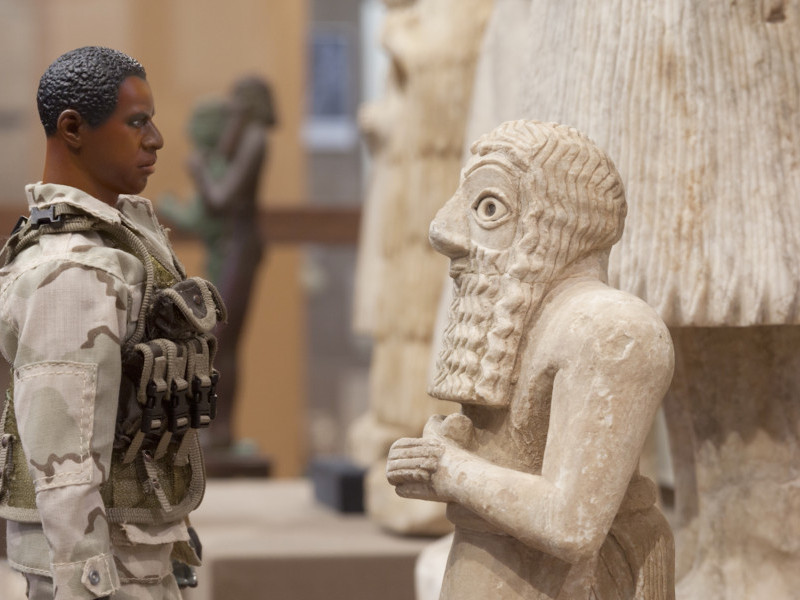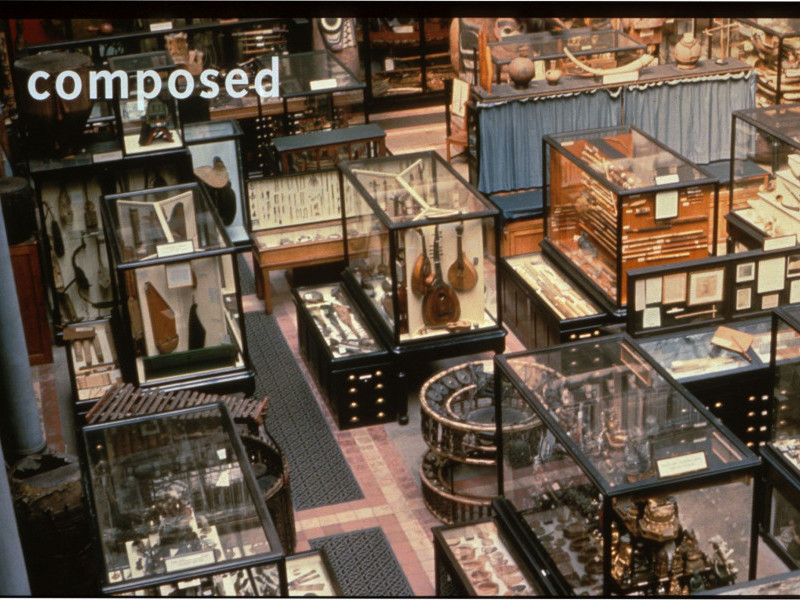
Unsettled Objects (1968–1969)
Lothar Baumgarten
Unsettled Objects (detail)
1968–1969
Collection Sharjah Art Foundation
Image courtesy of Marian Goodman Gallery, New
York, Paris, London, and the artist’s estate
search


Lothar Baumgarten
Unsettled Objects (detail)
1968–1969
Collection Sharjah Art Foundation
Image courtesy of Marian Goodman Gallery, New
York, Paris, London, and the artist’s estate
Since I was a child, I have been curious about the meaning of museum ‘collections’.
I remember the exact moment when I first encountered German artist Lothar Baumgarten’s Unsettled Objects (1968–1969). At the time, I was a young teenager shuttling back and forth between the so-called East and West. My eyes glinted with excitement as I looked towards Baumgarten’s work, which appeared as a carousel slide projection—a form of technology that at the time was already outdated. Yet, the fact that the technology was old did not make the clicking noise produced as each slide rotated into place any less alluring. Before me were images, familiar yet alien, of artefacts from the Pitt Rivers Museum in Oxford. My father had taken me there one weekend when he was temporarily working in the city. But without the animated tour guide who gave meaning to the thousands of objects in vitrines during my visit, the artefacts in the slides, relics of societies from the distant past, were hollowed of life. I began to wonder what it meant to care for an object and the kind of history that it represented.
A monumental new addition to the Sharjah Art Foundation Collection, Unsettled Objects is emblematic of the collection’s direction. One of the great conceptual artists of his generation, Baumgarten alluded to what I would later come to know as postcolonial theory. However, he did so before such a collective school of thought existed. The work was completed nearly a decade before Edward W. Said’s iconic text Orientalism (1978), which made visible how Western culture had patronised the East or ‘The Other’ through its literature, art and historical narratives. It became clear to me from a young age that the American-English education I had received had left many blind spots that needed to be filled. Early on, museums became a benchmark for me as to how to develop different ways of seeing. Although I did not usually encounter many museums, as I spent the majority of my teenage years in a place where such places did not exist, when I was able to travel and study the ‘unsettled objects’ in such institutions as the British Museum and the Metropolitan Museum of Art, I would return to Baumgarten and enquire what could live alongside the ‘art’ objects before me to give them vitality. Or rather, how could they be shown in ways that brought them back to life? What we learn from Baumgarten is that collections in museums can be repositories of either life or death. They are the traces that remain when an exhibition closes, the iconic landmarks that continue to resurface for different generations to engage and consider.
A unique beacon in the world of art, the Sharjah Art Foundation Collection seeks to interrogate the practice of institutional collecting and lay a foundation for an art history that takes an East/East, South/South approach to collecting. The Foundation’s collection originated from site-specific works produced for the Sharjah Biennial, to which works from other Foundation exhibitions and programmes were subsequently added. Over time, that remit has transformed into a plan for an intergenerational map of history, from the 1920s to the present, in every modern and contemporary medium imaginable. Taking the Middle East and South Asia as a starting point, the collection seeks to chart how ideas translate across geographies, often through shared histories of tumult related particularly to war, decolonisation and independence, as well as social and political identity.
The collection’s acquisition strategy also includes a concerted effort to think of innovative mechanisms and modes of display to be employed in the opening of the new permanent storage space and museum for the collection, which was announced last year. In the meantime, works from the collection can be seen in rotating exhibitions in the Foundation’s exhibition spaces and in various international exhibitions and biennials, including its own. For example, three landmark paintings from the collection by the late Syrian painter Marwan were featured in Sharjah Biennial 14, and other works from the collection are being presented in travelling exhibitions all over the world. For example, nearly two dozen works by the late Emirati artist Hassan Sharif make up a large part of the exhibition I Am The Single Work Artist, currently installed at the KW Institute for Contemporary Art, Berlin. Initiated and curated by Foundation President and Director Hoor Al Qasimi, this exhibition was on view in Sharjah in 2017, and after Berlin, it will continue on to Malmö Konsthall in Sweden. In addition to these institutions, the Foundation has shared works from its collection with Haus der Kunst, Munich; the Museum of Modern Art, New York; and the Jameel Arts Centre, Dubai, among others.
Currently on loan to the Jameel Art Centre are a number of works by Iraqi-American artist Michael Rakowitz. One of the works on view at the Jameel Art Centre, The Ballad of Special Ops Cody (2017), is a recent acquisition to the Sharjah Art Foundation Collection, which was also recently on view in Sharjah Biennial 14. Like many of the artists with works in the collection, Rakowitz has had a long relationship with the Foundation, making his first appearance in Sharjah Biennial 8 (2007). Recently featured in both the 2nd Lahore Biennial, curated by Hoor Al Qasimi, and Sharjah Biennial 14: Leaving the Echo Chamber, The Ballad of Special Ops Cody was commissioned for Rakowitz’s first solo exhibition in a museum in 2017, humorously titled Backstroke of the West. Much like Baumgarten, Rakowitz seeks to question the ways in which museology displaces personal and political histories. In the video, the main character and narrator is Special Ops Cody, an action figure of an African American soldier manufactured during the Second Iraq War. Cody roams the shelves and vitrines of the Oriental Institute at the University of Chicago and interacts with Mesopotamian votive statues. The Ballad of Special Ops Cody layers two divergent histories torn apart by centuries: that of our perennially permeable present, in which conflict and daily trauma sit side by side on the social media stream with advertising for consumable goods, and that of ancient civilisations, with their experience of collapse, displacement and ultimate disappearance. Who owns these histories? Are they ours to tell?
It is a truly unique feat to be able to house Rakowitz’s The Ballad of Special Ops Cody in our collection alongside Baumgarten’s newly acquired Unsettled Objects—two works proffering two different views on the history of museology. And in these trying social, political and economic times, it feels more urgent than ever to find spaces where we can come together, virtually if not in real time, to bear witness to different experiences and perspectives through art. Over the coming weeks, we will unveil works from the Sharjah Art Foundation Collection via social media platforms through photos, posts, blogs, selected online screenings and clips, and we hope, in the years to come, in many other ways as well. To launch our digital initiative, with the generous consent of the artist, we will be sharing The Ballad of Special Ops Cody online in its entirety for audiences to see from home.
Dr Omar Kholeif is the Director of Collections and Senior Curator at Sharjah Art Foundation.

Video
14 minutes 42 seconds

The 81 slides in Unsettled Objects (1968–1969), images of artefacts from the Pitt Rivers Museum in Oxford that are shown by a carousel projector, make visible how European and Western museums present and store their so-called ethnological and anthropological ‘treasures’